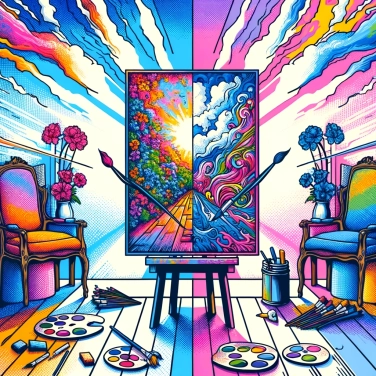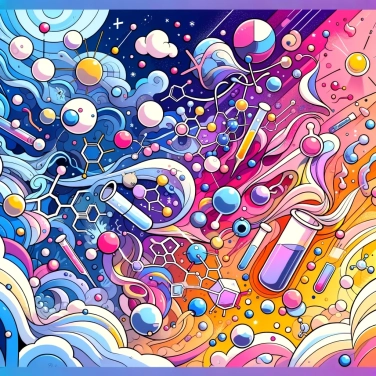The colors of paintings fade over time primarily due to exposure to light, moisture, heat, and chemical reactions with air or other surrounding materials. These factors alter the pigments and binders of the paints, causing a gradual discoloration.

Light plays a key role in the gradual degradation of colors. More specifically, it is the ultraviolet (UV) rays from the sun that pose a problem. These rays have enough energy to break the molecules of pigments, leading to a permanent change in their original color. As a result, hues become dull, fade, or change in shade over time. Not all colors are equal when it comes to UV exposure: some, like reds and yellows, are generally more sensitive to this degradation than blues or greens. In general, prolonged and direct exposure significantly accelerates this aging phenomenon of paints.
Over time, some pigments undergo chemical reactions and completely change in appearance. This is often due to the fact that air contains oxygen, which slowly attacks the molecules responsible for the beautiful original colors. The result: bright hues lose their luster. The famous vermilion red sometimes turns a dull brown, precisely because the sulfur it contains undergoes a slow oxidation. The same principle applies to certain blues or yellows: their molecules gradually change when exposed to air, leading to dull colors or ones that are completely different from those originally sought by the artist. Not very nice, these slow chemical reactions that gradually diminish the intensity of the paintings we once loved to admire!
Humidity is particularly troublesome for paintings, as it seeps into the inner layers and weakens their adhesion. The result: blisters, peeling, or mold can appear, making the canvas much less attractive. Then there are temperature fluctuations, which, by expanding and contracting materials depending on whether it's hot or cold, create tiny cracks at first that become bothersome in the end. When these cracks widen, the pigments lose stability and the color gradually becomes dull or uneven. In short, an unstable or humid climate causes your favorite painting to age more quickly.
The quality of the materials chosen from the outset directly influences how a paint ages. Cheap or lower-quality pigments generally lose their vibrancy quickly, as they are more sensitive to chemical and physical degradation. In contrast, artists who choose paints made with pure pigments and durable binders see their colors maintain their quality longer without fading or changing hue. The chemical stability and lightfastness of the components used clearly make a difference in the long run. Buying cheaper often means saving on the longevity of color over time.
The frequent use of solvents or overly aggressive cleaning products can gradually degrade the colors of paints. These compounds often attack the outer protective layer (varnish), making it opaque or completely dissolving it, thus directly exposing the pigments. As a result, these pigments become more sensitive to deterioration and fade much more quickly, giving the paint a faded or washed-out appearance. When they penetrate deeper, these products can sometimes cause unexpected chemical reactions, permanently altering certain sensitive pigments, particularly those of organic origin. Even spot cleaning, if done improperly, can leave lasting damage on the artwork.
Did you know that Leonardo da Vinci used unstable pigments to paint The Last Supper, which quickly led to its deterioration and required numerous restoration efforts over the centuries?
Did you know that paints containing lead-based pigments, which are now banned, had excellent resistance to deterioration caused by time and light?
Did you know that certain soils and natural minerals traditionally used to obtain pigments can change color radically when exposed to moisture or air acidity?
Did you know that some ancient paintings were specially formulated to gradually lighten in order to reveal hidden details over time?
In general, discoloration caused by chemical reactions related to continuous exposure to UV light or oxidation is challenging to reverse. However, some superficial alterations can sometimes be mitigated or restored by a qualified professional conservator, who is able to accurately assess the extent of the damage and the appropriate solutions.
To preserve a work of art over time, it is important to limit its direct exposure to sunlight while controlling the humidity and temperature of the conservation environment. Indirect lighting filtered through UV-protective glass, a controlled environment (with stable humidity around 40-50% and a constant temperature around 18-21°C), and the regular application of a suitable protective varnish can significantly slow down the degradation of colors.
Although modern paints often benefit from advanced chemical formulations and more light-resistant pigments, they are not completely immune to fading. Improper exposure, poor material choices, or insufficient pigment quality can accelerate their deterioration even in contemporary paints.
Yes, certain forms of artificial lighting, such as unfiltered fluorescent or halogen lamps, can indeed emit ultraviolet radiation in small amounts, leading to a gradual fading of sensitive colors. It is recommended to use specific lighting, such as UV-free LED lights, to preserve the colors of paintings over time.
Paints made from inorganic or mineral pigments, such as iron oxide or clay-based pigments, are generally more resistant to fading than those made from organic pigments that are sensitive to UV radiation. High-quality oil or acrylic paints, protected by specific UV-resistant varnishes, also offer better durability over time.

0% of respondents passed this quiz completely!
Question 1/5